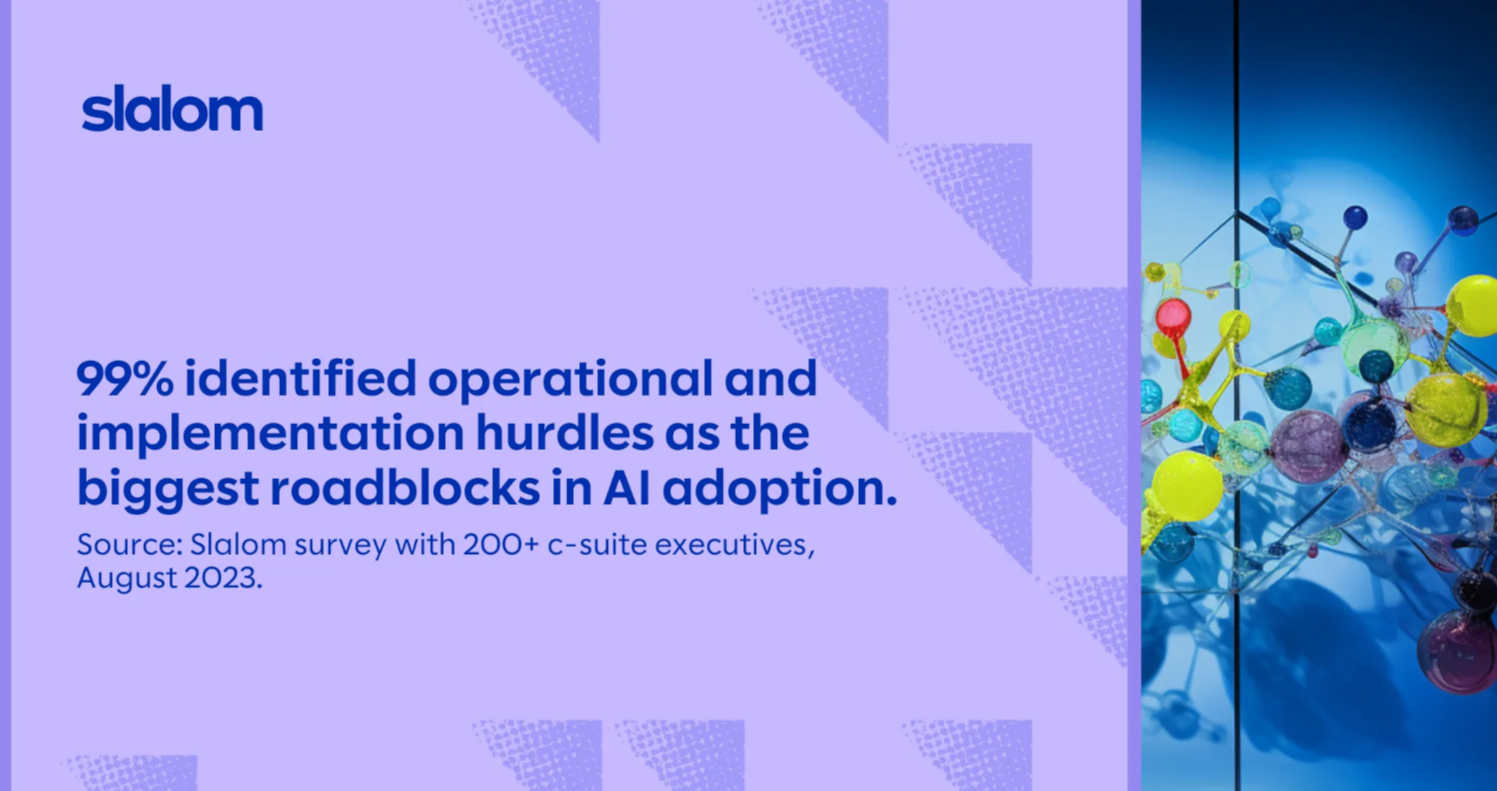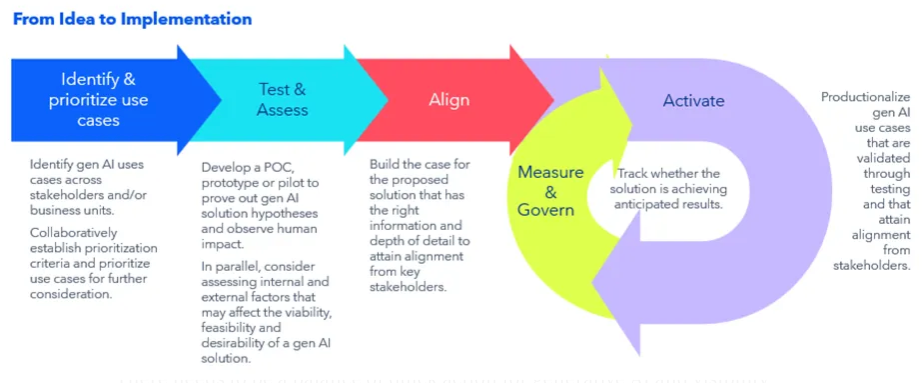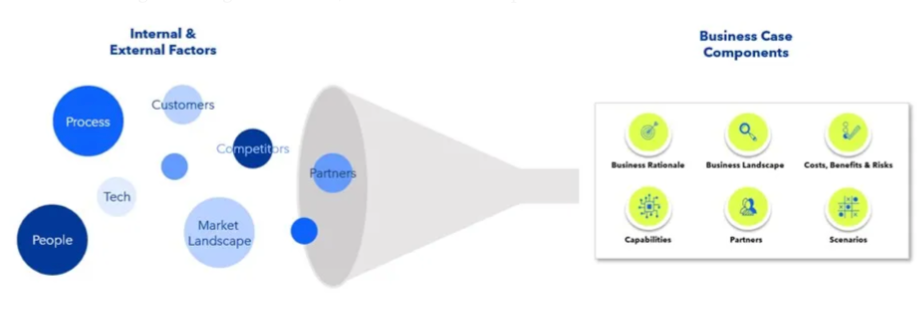The case for the generative AI business case

According to analysis conducted by Statista, worldwide investment in generative artificial intelligence (AI) has almost doubled in just three years from $49B to $92B. Given the speed at which generative AI is advancing and gaining traction, it’s no wonder so many leaders are interested in diving into building solutions with generative AI technology as quickly as possible. In a survey of executives conducted by Slalom, only 7% had not yet begun considering their AI transformations.* In such a market, speed is important — but going fast without intention or established direction can result in more chaos than value.
When speed is of the essence, how do you know when it makes sense to step back, assess generative AI use cases, and develop a comprehensive business case to establish direction and alignment before launching into solution development? And when would a brief assessment suffice?
Should you develop a business case?
First, consider the risk and financial posture of your company. How much time, effort, and budget will the proposed generative AI solution require to be developed and then sustained over time? How complex is the solution? How big is the impact of the solution?
If you’re thinking about developing a simple generative AI solution that takes a team member just a few weeks to implement and will improve employee experience substantially, then cost and risk are low, and benefit is high. Most organizations will probably move forward with an initiative of this nature with just a few slides to explain the “why” behind the solution and the timeline to deliver it. As the complexity and potential impact of a solution go up, the costs and risk of the solution go up, and the financial and risk posture of your organization may warrant taking some time for a thorough review before committing to development.

Given that an overwhelming 99% of the executives we surveyed identified operational and implementation hurdles as the biggest roadblocks in AI adoption, the ability to differentiate between a low-assessment solution and one that requires a substantial time investment is paramount.
When navigating the journey with generative AI, ask yourself, “How likely is it that my organization is going to end up running a number of generative AI proofs of concept?” and “How likely is it that we will develop multiple generative AI-powered solutions within the next few years?” Given the speed of adoption and advancement of generative AI capabilities, the answer to these questions is probably “very likely” for many organizations.

If your organization is planning to invest in generative AI, then, at minimum, consider a brief assessment effort and one-page business case for the solution you are seeking to develop. About 47% of executives surveyed by Slalom believe that the use of AI will help them gain a competitive advantage, but only 24% have a clear vision for their AI transformation. This gap in a clear plan to achieve a competitive advantage further emphasizes the importance of setting intention with a business case. How can an organization achieve a competitive advantage if they have not defined and strategically managed their desired outcomes and advantages?
How detailed should the assessment and business case be?
Next, consider what depth of assessment and business case might be appropriate. A full-scale assessment and business case can take a few months and may involve research and workshops to assess a need and potential solutions; prioritizing options; testing an idea or two via a proof of concept, prototype or pilot; and then developing a business case complete with elements such as a market scan, competitive assessment, financial model, and cost-benefit analysis.
But not every generative AI use case requires this depth of assessment. Tailor your assessment to reflect the complexity and potential impact of the solution, as well as to influence those from whom you need to attain alignment, approval, and/or budget allocation. Research and workshops can take anywhere from hours to weeks, and a business case can be as simple as a one-page business canvas or as comprehensive as a 60-page slide deck.
When it comes to assessing opportunities, we take a pragmatic approach. You don’t need to boil the ocean to adequately assess an opportunity. You need to have the right insights to feel ready and confident about getting started and to influence other stakeholders.
Apply a fiercely human lens to assessing generative AI use cases
As part of our holistic approach to building a business case, we believe in a fiercely human approach to assessing generative AI use cases. This means taking time to consider the impact that a generative AI solution will have on people such as customers, employees, or partners.
We highly encourage testing generative AI solution ideas via a proof of concept, prototype, or pilot. Our clients frequently express a desire to build something to show progress as soon as possible, and a POC, prototype, or pilot can help fulfill the desire to see a solution in action and have tangible progress to report.
Even more important, testing enables you to see how humans interact with a solution and understand how the solution will fit into their workflow or experience. There are often observations made by test participants or observers about the experience of working or interacting with a new technology solution that wouldn’t have been anticipated in a business case assessment.
Furthermore, test participants often ask questions that reveal perspectives that may not have otherwise been considered; bringing a diverse set of stakeholders into a test environment is invaluable because their varying experiences and views will help you ensure no stone is left unturned. Questions about generative AI equity and ethics are often raised by test participants that had not previously been considered.

What kind of approach should I take?
Once an organization has a portfolio of generative AI solutions in motion, it starts to make sense to have a central person, team, or center of excellence tracking the overall management, governance, costs, and benefits of generative AI solutions. The costs of generative AI can quickly balloon depending on how it is being used in an organization, similar to how in the early days of cloud technology adoption costs ballooned at some companies as leaders in teams across companies started swiping credit cards to stand up cloud environments and take advantage of the ability to rapidly deploy new solutions with less red tape and wait time than ever before. Let’s learn from this.
There needs to be a balance of quick action for generative AI and visibility into the effort and cost. A business case can establish the methods to manage an organization’s approach at its infancy, which will ultimately speed up its ability to scale and implement in the future. This can be done before solution development or iterated on in parallel with initial development, depending on an organization’s risk posture and timeline needs.
A portfolio of generative AI solutions managed centrally can lead to better volume pricing with technology partners than if each project or program is quoted separately. Additionally, a central team or leader overseeing the impact of generative AI at your organization will seek to understand the objectives and measures of success for each solution to be able to track and determine whether a solution is delivering the intended outcomes and ROI.
How organizations are navigating these decisions
We find that productivity use cases often require just a few slides to outline the need, solution, timeline, budget, and success metrics for alignment and approval. With low implementation costs and risks, the potential productivity gains justify the time and budget for at least a proof of concept to evaluate the solutions.
For example, one life sciences client is exploring the use of generative AI to identify changes in internal standards. Because the targeted users have expertise on the subject, they are equipped to detect inaccuracies and seek other sources when needed, which helps mitigate any risk.
In another instance, a retail company is interested in using generative AI to help understand complex datasets. Again, users will have some familiarity with the data and its potential. Therefore, if the generative AI solution provides inaccurate insights, they will have the expertise to flag suspect data and the ability to inquire further. The AI becomes a productivity partner for the employees rather than a replacement.
We find that generative AI use cases with the potential to transform your organization’s entire model or to raise significant ethical concerns tend to engender higher risk and/or cost. These complex use cases necessitate an equally complex and thorough business case assessment process.
 Information about a variety of internal and external factors can be gathered and assessed to produce a business case, which may include some (or all) of these areas of focus, depending on the level of detail needed.
Information about a variety of internal and external factors can be gathered and assessed to produce a business case, which may include some (or all) of these areas of focus, depending on the level of detail needed.
For example, an automotive organization is considering adopting Tesla’s ecommerce model for selling cars, integrating generative AI into the experience. This shift from dealerships to ecommerce could radically alter the organization’s operations, finances, and customer experience. Because of the profound implications, we’ve advised evaluating benefits, costs, risks, competition, buyer personas, opportunities to serve key segments, supporting capabilities, and organizational impacts. The risk of neglecting this assessment is significant, as large opportunities for gain often come with substantial risks of loss or failure.
In another case, a healthcare provider is considering generative AI to predict claim denials, enabling proactive adjustments for quicker processing. However, known biases in insurance decisions, possibly linked to race or socioeconomic factors, create a substantial risk. These biases could inadvertently affect claim handling, making it crucial to evaluate risks, implement cross-checks, identify biases, and possibly refine generative AI models to ensure fairer outputs despite historical data biases.
How will you start your journey with generative AI?
We challenge you to start thinking about where generative AI could make sense in your company and the level of impact it could have on your organization. What level of assessment and business case might make sense for the kinds of ideas you are imagining?
Our research found that 66% of executives do not have a clear understanding of the tasks AI can augment or automate in their organizations. With that in mind, no matter what person or organization you look to for guidance on your generative AI journey, find a partner that will work flexibly with you and meet you where you are.
*Slalom conducted a survey of 200 C-suite-level executives on their AI transformations.
This blog post was originally published here.



